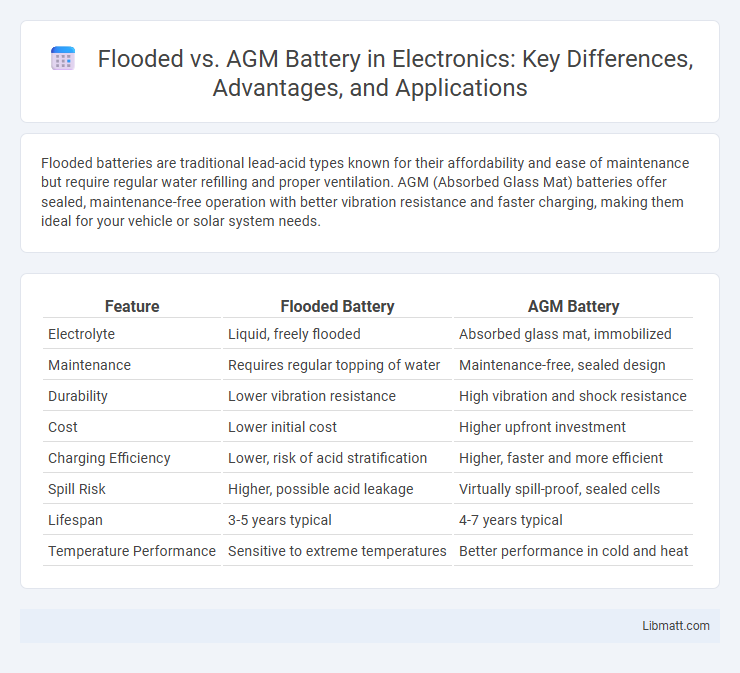Flooded batteries are traditional lead-acid types known for their affordability and ease of maintenance but require regular water refilling and proper ventilation. AGM (Absorbed Glass Mat) batteries offer sealed, maintenance-free operation with better vibration resistance and faster charging, making them ideal for your vehicle or solar system needs.
Table of Comparison
| Feature | Flooded Battery | AGM Battery |
|---|---|---|
| Electrolyte | Liquid, freely flooded | Absorbed glass mat, immobilized |
| Maintenance | Requires regular topping of water | Maintenance-free, sealed design |
| Durability | Lower vibration resistance | High vibration and shock resistance |
| Cost | Lower initial cost | Higher upfront investment |
| Charging Efficiency | Lower, risk of acid stratification | Higher, faster and more efficient |
| Spill Risk | Higher, possible acid leakage | Virtually spill-proof, sealed cells |
| Lifespan | 3-5 years typical | 4-7 years typical |
| Temperature Performance | Sensitive to extreme temperatures | Better performance in cold and heat |
Overview of Flooded and AGM Batteries
Flooded batteries, also known as lead-acid batteries, contain a liquid electrolyte that freely covers the battery plates, making them cost-effective and widely used for automotive and solar applications. AGM (Absorbent Glass Mat) batteries feature a fiberglass mat that absorbs the electrolyte, offering better resistance to vibration, lower maintenance, and improved performance in deep-cycle and high-demand environments. Your choice between these two types depends on the specific energy requirements, budget, and maintenance preferences.
Key Differences Between Flooded and AGM Batteries
Flooded batteries use liquid electrolyte that requires regular maintenance, while AGM batteries feature a sealed, absorbent glass mat design that is spill-proof and maintenance-free. AGM batteries offer better vibration resistance and faster charging capabilities, making them ideal for high-performance and deep-cycle applications. Understanding these key differences helps you choose the right battery for your vehicle or backup power needs, balancing cost, durability, and maintenance preferences.
Construction and Design Features
Flooded batteries feature a liquid electrolyte composed of sulfuric acid and water, housed in a vented casing that allows gases to escape during charging, requiring regular maintenance to check fluid levels. AGM (Absorbent Glass Mat) batteries utilize a fiberglass mat separator to absorb the electrolyte, creating a sealed, spill-proof design that improves vibration resistance and minimizes maintenance. The robust, sealed construction of AGM batteries enhances durability and allows for installation in various orientations, unlike the open design of flooded batteries.
Performance and Efficiency Comparison
Flooded batteries offer reliable performance with a high tolerance for overcharging and deep discharges, making them efficient for stationary applications but requiring regular maintenance to optimize lifespan. AGM batteries provide superior efficiency through lower internal resistance and faster recharge times, enhancing your vehicle's starting power and overall reliability with a maintenance-free design. Your choice depends on whether you prioritize cost-effective durability with flooded options or higher performance and convenience with AGM technology.
Maintenance Requirements
Flooded batteries require regular maintenance, including checking electrolyte levels and topping off with distilled water to prevent sulfation and ensure longevity. AGM batteries are sealed and maintenance-free, offering a more convenient option without the need for water addition or electrolyte monitoring. Your choice depends on whether you prefer hands-on maintenance or a hassle-free, sealed battery experience.
Lifespan and Durability
Flooded batteries typically offer a lifespan of 3 to 5 years with regular maintenance, while AGM (Absorbent Glass Mat) batteries last longer, often between 4 to 7 years due to their sealed design and enhanced resistance to vibration. AGM batteries provide superior durability in harsh conditions, making them ideal for applications requiring reliable performance without frequent upkeep. Your choice should consider the maintenance commitment and the environmental factors impacting battery longevity.
Safety Considerations
Flooded batteries require regular maintenance to prevent acid spills and release of hydrogen gas, posing higher safety risks compared to AGM batteries. AGM batteries are sealed and designed to minimize electrolyte leakage and gas emissions, enhancing safety in confined or sensitive environments. Proper ventilation is still necessary for both types to avoid hazardous gas accumulation during charging.
Cost Analysis and Initial Investment
Flooded batteries typically have a lower initial purchase price, ranging from $80 to $150, making them more affordable for budget-conscious buyers. AGM batteries, priced between $150 and $300, demand a higher upfront investment but offer longer lifespan and maintenance savings. The cost analysis should factor in replacement frequency and maintenance expenses, where AGM batteries often provide better long-term value despite the higher initial cost.
Applications and Best Use Cases
Flooded batteries excel in deep cycle applications such as solar energy storage and golf carts due to their ability to handle frequent discharges and recharge cycles, making them cost-effective for stationary use. AGM batteries, known for their sealed design and low maintenance, are ideal for high-performance vehicles, marine applications, and backup power systems where vibration resistance and spill-proof operation are crucial. Your choice between flooded and AGM batteries should consider the specific demands of your application, balancing cost, maintenance, and environmental conditions.
Choosing the Right Battery for Your Needs
Flooded batteries offer cost-effective power with easy maintenance, ideal for applications where regular inspection and water refilling are manageable. AGM batteries provide superior vibration resistance, spill-proof design, and longer lifespan, making them suitable for environments requiring durability and minimal upkeep. Assess your power demands, maintenance preferences, and environmental conditions to determine which battery type best supports your energy needs.
Flooded vs AGM Battery Infographic

 libmatt.com
libmatt.com